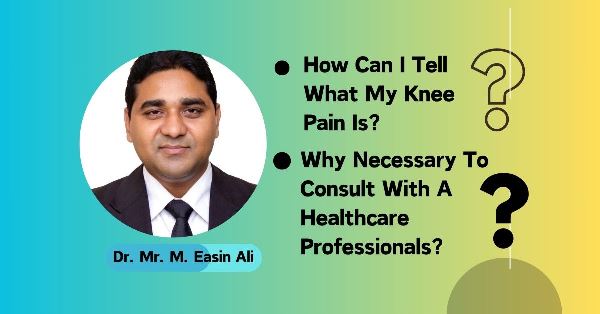How Can I Tell What My Knee Pain Is?
Is the pain located in the front, back, or side of your knee? Is the pain sharp or dull? Is the pain intermittent or persistent?

Hello guys, I’m Dr. Mr. M. Easin Ali, Consultant and Head of department of Physiotherapy, Pro-active Medical College and Hospital, Chairman, Dhaka City Physiotherapy Hospital. Today, I’m going to answers with you “What is knee pain and How to consult with A Healthcare Professionals”?
If you are experiencing knee pain, it is important to determine the underlying cause in order to receive the most appropriate treatment. There are a variety of conditions and injuries that can cause knee pain, and different treatment options will be more effective for different causes.
First, it is important to understand the location and type of pain you are experiencing.
- Is the pain located in the front, back, or side of your knee?
- Is the pain sharp or dull? Is the pain intermittent or persistent?
These questions can help you and your healthcare professional understand the source of the pain.
Next, consider any injuries or accidents you may have recently experienced. If you have had a fall, accident or direct blow to your knee, it is possible that you have suffered a sprain, strain, or tear. These types of injuries can cause pain, swelling, and stiffness and are treated by rest, ice, compression and elevation (RICE).
Another common cause of knee pain is osteoarthritis. This is a degenerative joint disease that can cause pain, stiffness, and difficulty moving the knee joint. Osteoarthritis is most commonly found in older adults, but can occur at any age. It is characterized by the wear and tear of the cartilage that cushions the knee joint.
Obesity is also a significant risk factor for knee pain, as extra weight puts added stress on the knee joint. If you are carrying extra weight, it is important to try to lose weight to alleviate knee pain.
Other causes of knee pain include gout, rheumatoid arthritis, and bursitis. Gout is a type of arthritis caused by the buildup of uric acid crystals in the joints, it is characterized by sudden and severe pain, redness, and swelling in the affected joint. Rheumatoid arthritis is an autoimmune disorder that causes inflammation in the joints and can lead to pain, stiffness, and difficulty moving the knee joint. Bursitis is an inflammation of the fluid-filled sacs (bursae) that cushion the knee joint and can cause pain, stiffness and swelling.
In some cases, the cause of knee pain may not be clear, and it can be a result of multiple factors. It’s essential to consult with a healthcare professional if you are experiencing knee pain to identify the underlying cause and determine the most appropriate course of treatment.
In addition to consulting a healthcare professional, you can also try the RICE method, which stands for rest, ice, compression, and elevation. Resting the knee and avoiding activities that cause pain can help reduce inflammation and speed up healing. Applying ice to the knee for 20-30 minutes at a time, several times a day can also help reduce inflammation and pain. Compressing the knee with an elastic bandage can help reduce swelling and provide support. Elevating the knee on a pillow or cushion when sitting or lying down can also help reduce swelling and pain.
Overall, knee pain can be caused by a variety of conditions and injuries, and it is important to determine the underlying cause in order to receive the most appropriate treatment. If you are experiencing knee pain, it is important to consult with a healthcare professional and try the RICE method to alleviate pain and reduce inflammation.
Why Necessary To Consult With A Healthcare Professionals?
Consulting a healthcare professional or registered physiotherapist, dietitian can provide numerous benefits when dealing with knee pain. They can:
Identify the underlying cause of knee pain:
A healthcare professional, such as a doctor or physiotherapist, can perform a thorough examination, review medical history and conduct any necessary diagnostic tests to identify the underlying cause of knee pain. This information is vital in deciding the most suitable treatment plan.
Develop an individualized treatment plan:
A healthcare professional can take into account an individual’s unique needs, medical history, and the underlying cause of knee pain to develop a treatment plan that is tailored to their specific needs.
Provide guidance on medication:
A healthcare professional can prescribe medication, if needed, and monitor for any potential side effects. They can also advise on the use of over-the-counter pain relievers.
Recommend physical therapy:
A healthcare professional can refer an individual to a physical therapist who can help improve strength, flexibility, and range of motion in the knee joint and teach exercises to help alleviate pain and prevent further injury.
Provide guidance on diet and lifestyle changes:
A registered dietitian can provide guidance on incorporating anti-inflammatory foods into the diet, maintaining a healthy weight through a balanced diet, and regular physical activity, all of which can help alleviate knee pain and prevent further injury.
Monitor progress:
A healthcare professional or registered dietitian can monitor an individual’s progress, make adjustments to the treatment plan as needed, and provide ongoing support and guidance.
Overall, consulting a healthcare professional or registered dietitian can provide valuable expertise and guidance in managing knee pain, and can help ensure that an individual receives the most appropriate and effective treatment for their specific needs.
What is better for knee pain heat or cold?
Knee pain can be treated with either heat or cold therapy, depending on the cause of the pain and the stage of healing. Both heat and cold therapies have their own advantages and disadvantages, and it’s important to understand when to use which one to get the best results.
Cold therapy:
also known as cryotherapy, is typically used to reduce inflammation, swelling, and pain in the early stages of an injury. Cold therapy can also be used to relieve pain associated with chronic conditions such as osteoarthritis. Applying cold therapy can help to constrict blood vessels and reduce blood flow to the affected area, which in turn can reduce inflammation and pain. Cold therapy can be applied in the form of ice packs, cold compresses, or even frozen gel packs.
Heat therapy:
Heat therapy is typically used to increase blood flow, relax muscles, and reduce stiffness in the later stages of healing. It’s can be used to relieve pain associated with chronic conditions such as fibromyalgia. Heat therapy can be applied in the form of hot packs, heating pads, or even warm compresses. The heat increases blood flow to the affected area, which can help to relax muscles and reduce stiffness.
It’s important to note that both heat and cold therapy should be used with caution, as overuse or improper use of either can cause damage or further injury. It’s best to consult with a healthcare professional or physical therapist to determine which therapy is best for you and how to use it safely and effectively.
In general, cold therapy is typically used in the acute phase of injury or pain, while heat therapy is used in the sub-acute or chronic.
Knee pain is a common ailment that affects many people, but it doesn’t have to be a permanent condition. In addition to incorporating anti-inflammatory foods into your diet, there are several other natural ways to help alleviate and prevent knee pain. These include:
Regular physical activity:
Engaging in regular physical activity can help improve strength, flexibility, and range of motion in the knee joint.
Maintaining a healthy weight:
Being overweight or obese can put extra stress on the knee joint, leading to pain and inflammation.
Stretching and strengthening exercises:
Stretching and strengthening exercises can help alleviate pain and prevent further injury
Hot and Cold therapy:
Alternating between hot and cold therapy can help reduce inflammation, swelling, and pain.
Wearing the right shoes:
Wearing shoes that provide proper support and cushioning can help reduce stress on the knee joint.
Finally,
It is essential to consult with a healthcare professional to develop an individualized plan that takes into account your unique needs and medical history. By implementing these natural strategies, you can reduce your risk of knee pain and manage current pain until it goes away completely.




